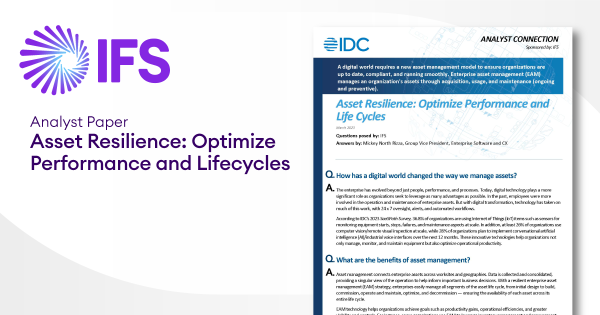Asset management has always been an important tool for helping organizations meet revenue, production, and profitability targets. In this digital world, it has become essential. In a recent IDC Future Enterprise and Resiliency Survey, wave 2, March 2023, 49% of organizations said they are still digitally transforming, and 51% said they are now running a digital business. From digital transformation to running the digital business, a plethora of new considerations exists for organizations to gage the health, and therefore the performance, of their assets.
Asset performance management, in the context of manufacturing, has been an avenue for organizations to manage the assets that assist with manufacturing goods for resale. Asset management is sometimes viewed as only a maintenance activity, such that the asset can continue to be utilized in good condition. But it also includes moving beyond the usage to performance of the asset.
In our IDC SaaSPath 2022 survey, IDC found 28% of organizations were managing their assets with predictive maintenance applied to anticipate asset repairs and replacements using actual asset performance data. In addition, in the same survey, 31.2% of organizations were using time-based predictive maintenance on assets and having them replaced on a planned schedule. When 59% of organizations can utilize their asset performance data and move their assets to a planned schedule, the organization is leveraging the digital information to maintain and run their business. When the asset health is taken into account and managed to meet the full requirements of the business, it can change the business for the better.
Organizations embracing APM find they can produce more and can improve their chances to make more money with greater product availability because their assets have more uptime. When an organization can take real-performance data, coupled with artificial intelligence (AI) and machine learning (ML), and predict when the asset will fail, a planned maintenance schedule can be put in place to reduce or even remove the opportunity for failure. When asset management is alignment through APM, organizations can predict when an asset will fail, prescribe what need to be done so it doesn’t fail, and in turn achieve healthier assets that become a real component of the business success.
Moving maintenance from a cost center to a profit center
The ability to bring together real-time asset performance, utilize AI and ML, and predictive maintenance to plan and schedule asset maintenance means the business can move beyond managing costs to proactively managing a profit center. Healthy assets enable reliability and the right level of organizational performance. Moving from maintaining assets with a cost benefit/failure analysis to ensuring healthy assets means the business can flourish by taking advantage of all its resources. In addition, when an organization moves beyond just maintaining assets to managing the health of the assets holistically, the asset focus shifts to the asset resource capabilities required to run the business profitably, meet revenue expectations, and focus on meeting an organization’s sustainability goals. These three areas allow the business to concentrate on what matters:
- Improving the revenue
- Reducing the carbon footprint
- Enhancing profitability
Utilizing the technology information to transform from a cost-centric focus to profitable demand response is a huge benefit in the digital business world. Not only does proactively managing the health of the assets enable a better performing organization, it also enables the business to focus on what really matters — revenue, profitability, and sustainability with the right health conscious assets. Monitoring asset health with APM likewise monitors the health of the business financially and sustainably.
Get your copy of the Analyst Connection by IDC

Do you have questions or comments?
We’d love to hear them so please leave us a message below.
